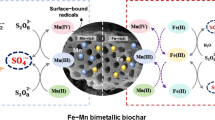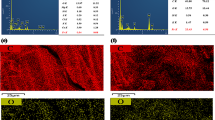Abstract
In situ metal stabilisation by amendments has been demonstrated as an appealing low-cost remediation strategy for contaminated soil. This study investigated the short-term leaching behaviour and long-term stability of As and Cu in soil amended with coal fly ash and/or green waste compost. Locally abundant inorganic (limestone and bentonite) and carbonaceous (lignite) resources were also studied for comparison. Column leaching experiments revealed that coal fly ash outperformed limestone and bentonite amendments for As stabilisation. It also maintained the As stability under continuous leaching of acidic solution, which was potentially attributed to high-affinity adsorption, co-precipitation, and pozzolanic reaction of coal fly ash. However, Cu leaching in the column experiments could not be mitigated by any of these inorganic amendments, suggesting the need for co-addition of carbonaceous materials that provides strong chelation with oxygen-containing functional groups for Cu stabilisation. Green waste compost suppressed the Cu leaching more effectively than lignite due to the difference in chemical composition and dissolved organic matter. After 9-month soil incubation, coal fly ash was able to minimise the concentrations of As and Cu in the soil solution without the addition of carbonaceous materials. Nevertheless, leachability tests suggested that the provision of green waste compost and lignite augmented the simultaneous reduction of As and Cu leachability in a fairly aggressive leaching environment. These results highlight the importance of assessing stability and remobilisation of sequestered metals under varying environmental conditions for ensuring a plausible and enduring soil stabilisation.






Similar content being viewed by others
References
Ahmad M, Moon DH, Lim KJ, Shope CL, Lee SS, Usman ARA, Kim KR, Park JH, Hur SO, Yang JE, Ok YS (2012) An assessment of the utilization of waste resources for the immobilization of Pb and Cu in the soil from a Korean military shooting range. Environ Earth Sci 67:1023–1031
Ahmed IAM, Hamilton-Taylor J, Lofts S, Meeussen JCL, Lin C, Zhang H, Davison W (2013) Testing copper-speciation predictions in freshwaters over a wide range of metal-organic matter ratios. Environ Sci Technol 47:1487–1495
Alvarenga P, Palma P, Goncalves AP, Fernandes RM, de Varennes A, Vallini G, Duarte E, Cunha-Queda AC (2009) Organic residues as immobilizing agents in aided phytostabilization: (II) effects on soil biochemical and ecotoxicological characteristics. Chemosphere 74:1301–1308
Amery F, Degryse F, Van Moorleghem C, Duyck M, Smolders E (2010) The dissociation kinetics of Cu-dissolved organic matter complexes from soil and soil amendments. Anal Chim Acta 670:24–32
Baken S, Degryse F, Verheyen L, Merckx R, Smolders E (2011) Metal complexation properties of freshwater dissolved organic matter are explained by its aromaticity and by anthropogenic ligands. Environ Sci Technol 45:2584–2590
Blissett RS, Rowson NA (2012) A review of the multi-component utilisation of coal fly ash. Fuel 97:1–23
Cao X, Ma L, Liang Y, Gao B, Harris W (2011) Simultaneous immobilization of lead and atrazine in contaminated soils using dairy-manure biochar. Environ Sci Technol 45:4884–4889
Caporale AG, Pigna M, Sommella A, Dynes JJ, Cozzolino V, Violante A (2013) Influence of compost on the mobility of arsenic in soil and its uptake by bean plants (Phaseolus vulgaris L.) irrigated with arsenite-contaminated water. J Environ Manag 128:837–843
Chen JJ, Thomas JJ, Taylor HFW, Jennings HM (2004) Solubility and structure of calcium silicate hydrate. Cem Concr Res 34:1499–1519
Craven AM, Aiken GR, Ryan JN (2012) Copper(II) binding by dissolved organic matter: importance of the copper-to-dissolved organic matter ratio and implications for the biotic ligand model. Environ Sci Technol 46:9948–9955
de la Fuente C, Clemente R, Alburquerque JA, Velez D, Bernal MP (2010) Implications of the use of As-rich groundwater for agricultural purposes and the effects of soil amendments on As solubility. Environ Sci Technol 44:9463–9469
Farrell M, Perkins WT, Hobbs PJ, Griffith GW, Jones DL (2010) Migration of heavy metals in soil as influenced by compost amendments. Environ Pollut 158:55–64
Gu HH, Qiu H, Tian T, Zhan SS, Deng THB, Chaney RL, Wang SZ, Tang YT, Morel JL, Qiu RL (2011) Mitigation effects of silicon rich amendments on heavy metal accumulation in rice (Oryza sativa L.) planted on multi-metal contaminated acidic soil. Chemosphere 83:1234–1240
Han FX, Su Y, Monts DL, Plodinec MJ, Banin A, Triplett GE (2003) Assessment of global industrial-age anthropogenic arsenic contamination. Naturwissenschaften 90:395–401
Hartley W, Lepp NW (2008) Effect of in situ soil amendments on arsenic uptake in successive harvests of ryegrass (Lolium perenne cv Elka) grown in amended As-polluted soils. Environ Pollut 156:1030–1040
Hartley NR, Tsang DCW, Olds WE, Weber PA (2014) Soil washing enhanced by humic substances and biodegradable chelating agents. Soil Sed Contam 23:599–613
Houben D, Evrard L, Sonnet P (2013) Mobility, bioavailability and pH-dependent leaching of cadmium, zinc and lead in a contaminated soil amended with biochar. Chemosphere 92:1450–1457
Jing C, Liu S, Patel M, Meng X (2005) Arsenic leachability in water treatment adsorbents. Environ Sci Technol 39:5481–5487
Khan MJ, Jones DL (2009) Effect of composts, lime and diammonium phosphate on the phytoavailability of heavy metals in a copper mine tailing soil. Pedosphere 19:631–641
Kimmell TA, Williams LR, Sorini SS (2001) The RCRA Toxicity Characteristic Leaching Procedure (TCLP): a concept for a new method. Federal Facilities Environmental Journal 12(3):7–24
Komarek M, Vanek A, Ettler V (2013) Chemical stabilisation of metals and arsenic in contaminated soils using oxides - A review. Environ Pollut 172:9–22
Kumpiene J, Lagerkvist A, Maurice C (2007) Stabilization of Pb- and Cu-contaminated soil using coal fly ash and peat. Environ Pollut 145:365–373
Kumpiene J, Lagerkvist A, Maurice C (2008) Stabilization of As, Cr, Cu, Pb and Zn in soil using amendments—a review. Waste Manag 28:215–225
Limbachiya M, Meddah MS, Fotiadou S (2012) Performance of granulated foam glass concrete. Constr Build Mater 28:759–768
Liu G, Fernandez A, Cai Y (2011) Complexation of arsenite with humic acid in the presence of ferric iron. Environ Sci Technol 45:3210–3216
Masue Y, Loeppert RH, Kramer TA (2007) Arsenate and arsenite adsorption and desorption behavior on coprecipitated aluminum:iron hydroxides. Environ Sci Technol 41:937–842
Mikutta C, Kretzschmar R (2011) Spectroscopic evidence for ternary complex formation between arsenate and ferric iron complexes of humic substances. Environ Sci Technol 45:9550–9557
Milne CJ, Kinniburgh DG, Van Riemsdijk WH, Tipping E (2003) Generic NICA–Donnan model parameters for metal-ion binding by humic substances. Environ Sci Technol 37:958–971
Miretzky P, Cirelli AF (2010) Remediation of arsenic-contaminated soils by iron amendments: a review. Crit Rev Environ Sci Technol 40:93–115
Moon DH, Kim KW, Yoon IH, Grubb DG, Shin DY, Cheong KH, Choi HI, Ok YS, Park JH (2011) Stabilization of arsenic-contaminated mine tailings using natural and calcined oyster shells. Environ Earth Sci 64:597–605
Moon DH, Park JW, Cheong KH, Hyun S, Koutsospyros A, Park JH, Ok YS (2013a) Stabilization of lead and copper contaminated firing range soil using calcined oyster shells and fly ash. Environ Geochem Health 35:705–714
Moon DH, Park JW, Chang YY, Ok YS, Lee SS, Ahmad M, Koutsospyros A, Park JH, Baek K (2013b) Immobilization of lead in contaminated firing range soil using biochar. Environ Sci Pollut Res 20:8464–8471
Murcott S (2012) Arsenic contamination in the world: an international sourcebook. IWA Publishing, London, ISBN 1780400381
Neubauer E, Kohler SJ, von der Kammer F, Laudon H, Hofmann T (2013) Effect of pH and stream order on iron and arsenic speciation in boreal catchments. Environ Sci Technol 47:7120–7128
NZ MfE (2010) Proposed national environmental standard for assessing and managing contaminants in soil: discussion document. Ministry for the Environment, Wellington, New Zealand, ISBN: 978-0-478-33243-8
Oh C, Rhee S, Oh M, Park J (2012) Removal characteristics of As(III) and As(V) from acidic aqueous solution by steel making slag. J Hazard Mater 213:147–155
Ok YS, Kim SC, Kim DK, Skousen JG, Lee JS, Cheong YW, Kim SJ, Yang JE (2011) Ameliorants to immobilize Cd in rice paddy soils contaminated by abandoned metal mines in Korea. Environ Geochem Health 33:23–30
Olds WE, Tsang DCW, Weber PA (2013) Acid mine drainage treatment assisted by lignite-derived humic substances: metal removal and speciation modelling. Water Air Soil Pollut 224:1521
Padmavathiamma PK, Li LY (2010a) Phytoavailability and fractionation of lead and manganese in a contaminated soil after application of three amendments. Bioresour Technol 101:5667–5676
Padmavathiamma PK, Li LY (2010b) Effect of amendments on phytoavailability and fractionation of copper and zinc in a contaminated soil. Int J Phytoremediat 12:697–715
Pathan SM, Aylmore LAG, Colmer TD (2003) Properties of several fly ash materials in relation to use as soil amendments. J Environ Qual 32:687–693
Qi Y, Szendrak D, Yuen RTW, Hoadley AFA, Mudd G (2011) Application of sludge dewatered products to soil and its effects on the leaching behaviour of heavy metals. Chem Eng J 166:586–595
Reedy RC, Scanlon BR, Nicot JP, Tachovsky JA (2007) Unsaturated zone arsenic distribution and implications for groundwater contamination. Environ Sci Technol 41:6914–6919
Ruttens A, Adriaensen K, Meers E, De Vocht A, Geebelen W, Carleer R, Vangronsveld J (2010) Long-term sustainability of metal immobilization by soil amendments: cyclonic ashes versus lime addition. Environ Pollut 158:1428–1434
Santos S, Costa CAE, Duarte AC, Scherer HW, Scheider RJ, Esteves VI, Santos EBH (2010) Influence of different organic amendments on the potential availability of metals from soil: a study on metal fractionation and extraction kinetics by EDTA. Chemosphere 78:389–396
Shang C, Zelazny LW (2008) Selective dissolution techniques for mineral analysis of soils and sediments, vol SSSA Book Series, no. 5, Part 5th edn, Methods of soil analysis. Part 5. Mineralogical methods. Soil Science Society of America, Inc, Madison, pp 33–80
Sharma P, Rolle M, Kocar B, Fendorf S, Kappler A (2011) Influence of natural organic matter on As transport and retention. Environ Sci Technol 45:546–553
Tsang DCW, Hartley NR (2014) Metal distribution and spectroscopic analysis after soil washing with chelating agents and humic substances. Environ Sci Pollut Res 21:3987–3995
Tsang DCW, Yip ACK (2014) Comparing chemical-enhanced washing and waste-based stabilisation approach for soil remediation. J Soils Sediments 14:936–947
Tsang DCW, Graham NJD, Lo IMC (2009) Humic acid aggregation in zero-valent iron systems and its effects on trichloroethylene removal. Chemosphere 75:1338–1343
Tsang DCW, Olds WE, Weber PA (2013a) Residual leachability of CCA-contaminated soil after treatment with biodegradable chelating agents and lignite-derived humic substances. J Soils Sediments 13:895–905
Tsang DCW, Olds WE, Weber PA, Yip ACK (2013b) Soil stabilisation using AMD sludge, compost and lignite: TCLP leachability and continuous acid leaching. Chemosphere 93:2839–2847
Uchimiya M, Chang SC, Klasson KT (2011) Screening biochars for heavy metal retention in soil: role of oxygen functional groups. J Hazard Mater 190:432–441
US EPA (1992) Method 1311: Toxicity Characteristic Leaching Procedure. U.S. Environmental Protection Agency, Washington, DC
US EPA (1994) Method 200.2: Sample preparation procedure for spectrochemical determination of total recoverable elements. Revision 2.8. U.S. Environmental Protection Agency, Washington, DC
Wang YR, Tsang DCW (2013) Effects of solution chemistry on arsenic(V) removal by low-cost adsorbents. J Environ Sci 25:2291–2298
Wang S, Wu H (2006) Environmental-benign utilisation of fly ash as low-cost adsorbents. J Hazard Mater B136:482–501
Wang YR, Tsang DCW, Olds WE, Weber PA (2013) Utilizing acid mine drainage sludge and coal fly ash for phosphate removal from dairy wastewater. Environ Technol 34:3177–3182
Yeheyis MB, Shang JQ, Yanful EK (2009) Long-term evaluation of coal fly ash and mine tailings co-placement: a site-specific study. J Environ Manag 91:237–244
Yeheyis MB, Shang JQ, Yanful EK (2010) Feasibility of using coal fly ash for mine waste containment. J Environ Eng 136:682–690
Zhu YN, Zhang XH, Xie QL, Wang Q, Cheng GW (2006) Solubility and stability of calcium arsenates at 25 °C. Water Air Soil Pollut 169:221–238
Acknowledgements
The authors appreciate the financial support from the Brian Mason Scientific & Technical Trust (New Zealand) and the provision of field soil sample from Golder Associates (New Zealand) Ltd for this study.
Author information
Authors and Affiliations
Corresponding author
Additional information
Responsible editor: Zhihong Xu
Electronic supplementary material
Below is the link to the electronic supplementary material.
ESM 1
(DOC 124 kb)
Rights and permissions
About this article
Cite this article
Tsang, D.C.W., Yip, A.C.K., Olds, W.E. et al. Arsenic and copper stabilisation in a contaminated soil by coal fly ash and green waste compost. Environ Sci Pollut Res 21, 10194–10204 (2014). https://doi.org/10.1007/s11356-014-3032-3
Received:
Accepted:
Published:
Issue Date:
DOI: https://doi.org/10.1007/s11356-014-3032-3




